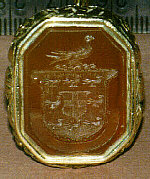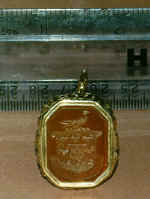
The Chaddock Seal

The Chaddock Seal

|
In 1993, sometime after Geoffrey had passed away, Peter investigated the Coat of Arms represented on the seal at the College of Heralds in London. Informally they said the arms appeared to be those of the family Chaddock, of Chaddock of Lancashire. Initially Peter was unable to find this location by map. It was not until April of 1998 that he discovered there was a Chaddock Lane in Astley, near Tyldesley, and in May of 1998 located further helpful information on Tony Smith's Boothstown Website after an Internet search of "Chaddock + Lancashire." Although the item was a valuable memento to his father, Peter, along with his sister Antonia, felt the seal should once again be a part of Chaddock family history. As soon as he was made aware of Chaddock Genealogy's Website, Peter offered to supply us with these photographs and to have the photographs examined at Christies for any additional information they could offer. In November of 1998, the seal was presented to a Chaddock family in the UK.2 The seal, believed to be 18th century in origin, is gold plated, with the Coat of Arms engraved in reverse on a stone of agate. One could speculate from the requirements of the day, that it was likely the possession of a clergyman. This might suggest that it belonged to Grace Chaddock, the last "Chaddock" occupant of Chaddock Hall, whose father Thomas Chaddock (d. 1723) was the Vicar of Eccles.3
|